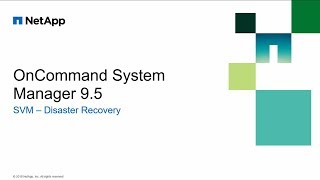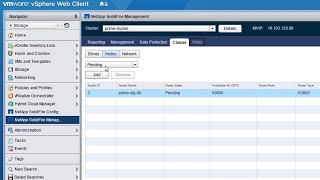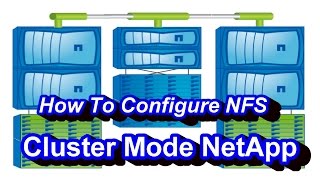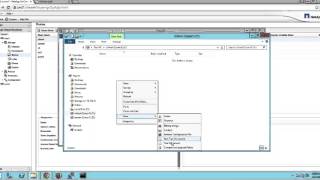Monday, 08 December, 2025г.
















Где искать: по сайтам Запорожской области, статьи, видео ролики
пример: покупка автомобиля в Запорожье
9 NetApp Terms You Need to Know
Reliant Technology
http://www.reliant-technology.com
1.877.227.0828
This video goes over some basic NetApp terminology such as:
SnapMirror
MetroCluster
SnapVault
WAFL
OnCommand
Data ONTAP
Aggregate
7-Mode
Clustered Data ONTAP
Video Summary:
SnapMirror:
SnapMirror is basically a way to duplicate a data, either within the same data center from one system to another just as a local backup, or rolled up to a remote site. It can be synchronous or asynchronous.
The SnapMirror is asynchronous or synchronous and it's used to move data between two NetApp systems at the same site or two separate sites.
MetroCluster:
MetroCluster requires that you have two identical systems, same setup, same configuration and it's synchronous real time. It's a cluster all the heads work together. Say you lose a whole site, you're still up and running.
SnapMirror is just a copy. Only one type running at a time. With MetroCluster you have both systems working active-active. But you have to have the same two.
Everything has to be identical, ONTAP version, everything, OS, the disks have to be identical. Everything.
SnapVault:
SnapVault is taking your SnapMirror copies and basically marking them as an archive forever. They can't be deleted, well they can, but you have to go through some trouble. You can't accidentally delete a vault. It's for long-term storage of your SnapMirror protected data. Let's say you've got 2 sites. You're running Exchange over here and you're SnapMirroring all your data over here. But over here, they're the same disks, expensive SAS disks. You SnapVault then to vault that data off to 6TB drives that are much cheaper.
SnapVault - you've got 2 sites. You got one in GA and one in CA. You're migrating data to protect it to California. Once it gets to California, you might want to create an archive copy for long-term retention to another class of disk using SnapVault.
WAFL:
WAFL is the lowest level. It's the file system. And it stands for “Write Anywhere File Layout” which basically means within an aggregate you want to write a file it's going to put it wherever it wants.
If I have a file it's not just going to write to one drive, it's going to write it all over the place simultaneously so that you have better write performance. Will it also impact read performance too?
Definitely. For sure, because the more spindles, the faster you have access.
OnCommand:
OnCommand is NetApp's suite of software that replaced FilerView. Basically it controls all your file heads within a site or multiple sites. Nowadays, rather than go on a command file on a particular filer and set up an aggregate and volume, etc., you go to one single pane of glass, one GUI, and you can see all your disks, all your volumes. If you need to grow a volume you do it there, even if you need to create a new one.
Data ONTAP:
That's the operating system. It's the Windows for filers let's say.
Just so I understand the difference between ONTAP and OnCommand, ONTAP is the operating system, and OnCommand allows you manipulate the OS or access the OS.
You wouldn't necessarily control ONTAP with OnCommand because ONTAP is the operating system. But you control all the features that you run on ONTAP.
Aggregate:
An aggregate is a pool of disks basically. Your volumes lives within your aggregates. We'll go into Raid DP, Raid Dual Parity. You have to have at least 3 drives. You can lose one of those drives and still be up and running.
Why would you have multiple aggregates on one filer? What would that allow you do, versus just one?
It may be performance, depending on the app that's running on one particular volume. You may have a heavy-hitting Outlook or Exchange, or Oracle. You want them to have their own aggregate so that they don't affect performance of the other aggregate.
7-Mode:
7-Mode is the older ONTAP version from that app. It's still supported. It's not supported on the 8000 series. It is on the 2500 series but it's still supported on all the older filers but they're phasing it out.
7-Mode is the older operating system that a lot of people have, but they're moving to something called Cluster Data On Tap.
They're doing that because with 7-Mode you can only have 2 controllers.
Clustered Data ONTAP:
With Cluster Mode you can have depending on the model, you can have up to 16 heads in a single cluster. What that let's you do is say you have a hardware problem with one head and you've got 6 heads in your cluster. You got to yank a whole head out, fix it, put it back, nothing goes down.
Теги:
NetApp (Venture Funded Company) Netapp terminology Data ONTAP Clustered Data ONTAP 7-Mode Aggregate NetApp Aggregate OnCommand NetApp OnCommand WAFL Write Anywhere File Layout SnapVault MetroCluster SnapMirror
Похожие видео
Мой аккаунт


 У вашего броузера проблема в совместимости с HTML5
У вашего броузера проблема в совместимости с HTML5


